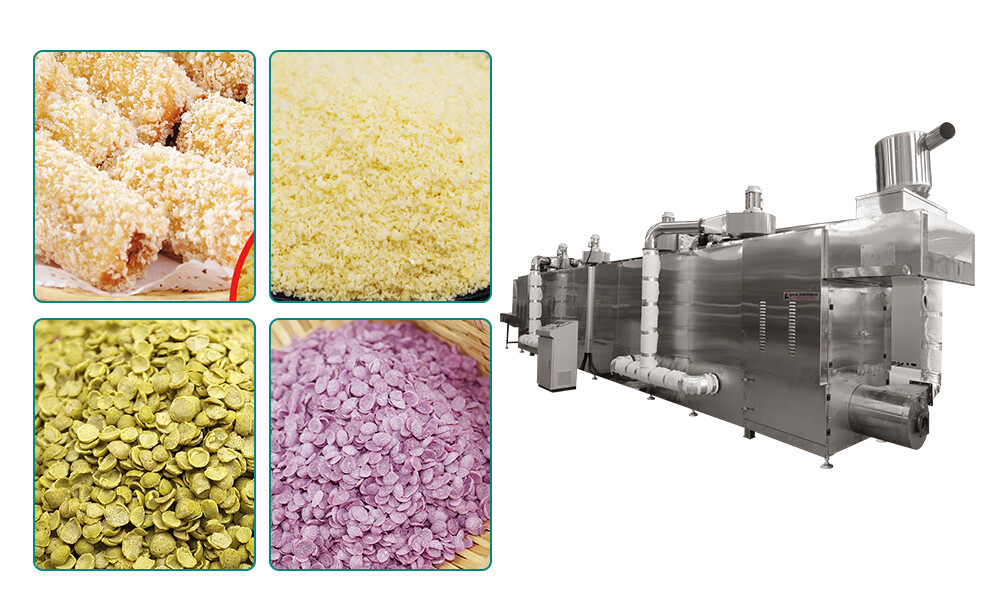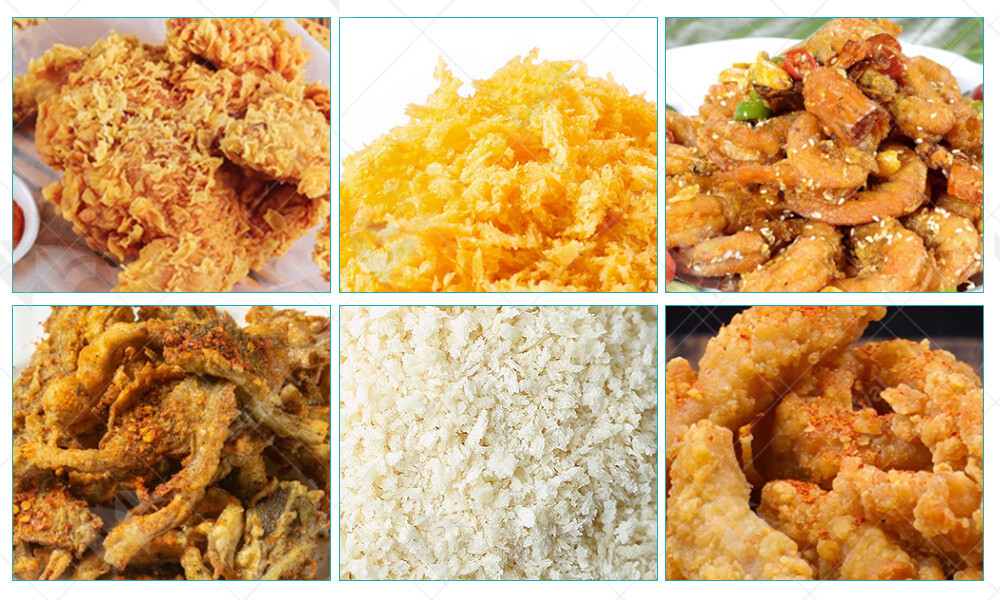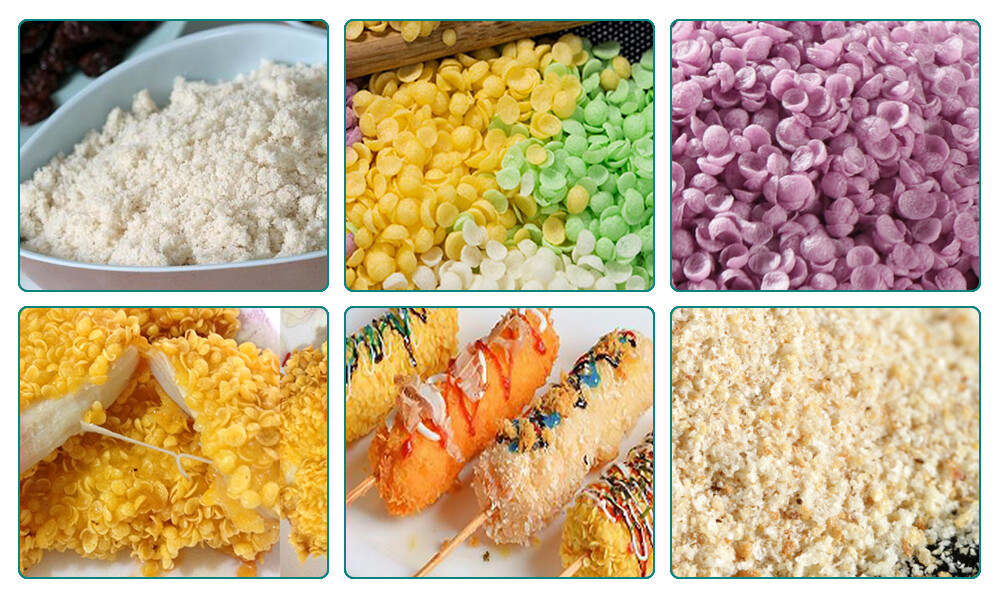The Ultimate Bread Crumbs Production Line Guide to 2024
Introduction to Bread Crumbs Production Lines
Bread crumbs are a staple ingredient in many culinary applications, from coating fried foods to adding texture to baked goods. The production of bread crumbs on an industrial scale requires specialized equipment and a well-organized production line to ensure consistency, quality, and efficiency. A Bread Crumbs Production Line is designed to handle large volumes of bread, transforming it into uniform crumbs through a series of automated processes.
The first stage in a Bread Crumbs Production Line is the preparation of the bread. This involves slicing and drying the bread to reduce its moisture content, making it easier to grind. Slicing machines are used to cut the bread into uniform pieces, while drying ovens or toasters ensure the bread reaches the desired level of dryness. Consistency in this stage is crucial for producing high-quality bread crumbs.
Once the bread is properly dried, it moves on to the grinding phase. Industrial grinders or mills are employed to crush the dried bread into crumbs of the desired size. These machines are equipped with adjustable settings to control the fineness of the crumbs, ensuring they meet specific requirements for various applications. The grinding process is followed by a sifting stage, where the crumbs are passed through screens to separate them by size and remove any unwanted large pieces.
Quality control is a critical aspect of the Bread Crumbs Production Line. Throughout the production process, samples are taken and tested to ensure the crumbs meet the necessary standards for texture, moisture content, and size. Automated inspection systems can be used to detect any irregularities, ensuring only the highest quality product reaches the packaging stage. This attention to detail helps maintain the reputation and reliability of the production line.
Finally, the bread crumbs are packaged and prepared for distribution. Packaging machines are used to fill bags or containers with the finished product, sealing them to preserve freshness. The packaging process can be customized to accommodate different sizes and types of packaging, depending on market demand. Proper labeling and storage are also essential to ensure the bread crumbs remain in optimal condition during transportation and shelf life.
Bread Crumbs Production Line integrates various stages of preparation, grinding, sifting, quality control, and packaging to produce consistent, high-quality bread crumbs efficiently. By employing advanced technology and maintaining strict quality standards, manufacturers can meet the growing demand for this versatile ingredient in the food industry.

Key Components of a Bread Crumbs Production Line
A Bread Crumbs Production Line is a complex assembly of various machines and equipment designed to efficiently produce bread crumbs. Understanding the key components of this production line is essential for anyone involved in the industrial food machinery sector. The main components are designed to work seamlessly together, ensuring consistent quality and high output.
The first critical component is the mixer. This machine is responsible for blending the bread dough, ensuring uniformity and consistency in the final product. The mixer must be capable of handling large volumes and maintaining precise control over the mixing process to ensure the dough's optimal texture and quality.
Next, the baking oven plays a vital role in the Bread Crumbs Production Line. The oven must be designed to bake the bread evenly, with precise temperature control to achieve the desired texture and moisture content. Modern ovens often come with advanced features like convection and steam injection to enhance baking efficiency and product quality.
After baking, the bread must be cooled and sliced. The cooling system ensures that the bread reaches an appropriate temperature for slicing without affecting its texture. The slicer then cuts the bread into uniform slices, which is crucial for the subsequent drying process. Accurate slicing is essential for producing consistent bread crumbs.
The final critical component is the crumb grinder. This machine grinds the sliced and dried bread into fine crumbs. The grinder must be robust and capable of producing uniform particle sizes to meet various product specifications. It should also be easy to clean and maintain to ensure hygiene and efficiency in the production line.
Each of these components—the mixer, baking oven, cooling system, slicer, and crumb grinder—plays an integral role in the Bread Crumbs Production Line. Their coordinated operation ensures that the production line runs smoothly, producing high-quality bread crumbs efficiently. For businesses in the food industry, investing in a well-designed production line with reliable components is essential for maintaining competitive advantage and meeting market demands.
Understanding these key components and their functions helps optimize the Bread Crumbs Production Line, ensuring that every stage of the process is efficient and the final product meets the highest standards of quality.

Advanced Technologies in Bread Crumbs Production
The Bread Crumbs Production Line has evolved significantly with the integration of advanced technologies, enhancing efficiency and product quality. These innovations are crucial for manufacturers aiming to stay competitive in the food industry.
One of the most notable advancements is the automation of the Bread Crumbs Production Line. Automation technologies, including programmable logic controllers (PLCs) and robotics, streamline the production process. Automated systems reduce human error, increase production speed, and ensure consistent quality. For example, robots can handle repetitive tasks such as loading and unloading baking trays, significantly boosting productivity.
Another significant technology is the implementation of advanced drying systems. Traditional drying methods can be time-consuming and inconsistent. Modern Bread Crumbs Production Lines now utilize infrared and microwave drying technologies. These methods provide precise control over moisture content, ensuring uniform drying and preventing over-drying or burning. As a result, the final product has a consistent texture and longer shelf life.
The use of real-time monitoring and data analytics is also transforming bread crumbs production. Sensors placed throughout the production line collect data on various parameters such as temperature, humidity, and production speed. This data is then analyzed to optimize the production process, identify potential issues, and implement preventive maintenance. This predictive approach reduces downtime and maintains the continuous operation of the Bread Crumbs Production Line.
Lastly, advancements in material handling systems have improved the efficiency of bread crumbs production. Pneumatic conveyors and vacuum systems are now widely used to transport materials seamlessly throughout the production line. These systems are gentle on the product, reducing breakage and ensuring that bread crumbs retain their intended texture. Additionally, they minimize contamination risks, maintaining high hygiene standards.

Essential Equipment for Bread Crumbs Manufacturing
| Equipment | Description |
| Mixer | Blends bread dough uniformly for consistent texture and quality. |
| Baking Oven | Bakes bread with precise temperature control to achieve the desired moisture content. |
| Cooling System | Cools baked bread to the appropriate temperature for slicing without affecting texture. |
| Slicer | Cuts cooled bread into uniform slices for optimal drying and grinding. |
| Drying Oven | Dries sliced bread to reduce moisture content, preparing it for grinding. |
| Crumb Grinder | Grinds dried bread slices into fine, uniform crumbs. |
| Conveyor Belts | Transports bread through various stages of the production line efficiently. |
| Sieving Machine | Ensures uniform crumb size by separating larger particles from the fine crumbs. |
| Packaging Machine | Automates the packing of bread crumbs into bags or containers for distribution. |
| Metal Detector | Ensures product safety by detecting and removing any metal contaminants. |
| Quality Control System | Monitors and maintains the quality standards throughout the production process. |
| Control Panel | Centralized system for managing and controlling all machinery in the Bread Crumbs Production Line. |

Automation and Efficiency in Bread Crumbs Production
| Key Aspect | Description |
| Automated Mixing Systems | Ensures consistent dough quality and reduces manual labor. Integral for maintaining efficiency in the Bread Crumbs Production Line. |
| Continuous Baking Ovens | Facilitates uniform baking and higher throughput. Automation in temperature control enhances product consistency. |
| Automated Cooling Conveyors | Efficiently cools baked bread to optimal slicing temperature. Reduces cooling time and manual handling. |
| Precision Slicers | Automatically slices bread uniformly. Essential for consistent crumb size and quality. |
| Automated Drying Systems | Ensures even drying of bread slices. Automation optimizes moisture control, crucial for the final Bread Crumbs Production Line. |
| Advanced Grinding Machines | Automatically grinds bread to desired crumb size. Enhances uniformity and production speed. |
| Inline Quality Control | Automated systems check for consistency and quality throughout the production process. Reduces waste and ensures product standards. |
| Real-Time Monitoring | Utilizes sensors and software for continuous monitoring. Helps in maintaining efficiency and identifying issues promptly. |
| Automated Packaging Lines | Ensures efficient and hygienic packaging of bread crumbs. Reduces manual labor and speeds up the packaging process. |
| Energy Management Systems | Monitors and optimizes energy usage across the production line. Essential for reducing operational costs and increasing efficiency. |
By implementing these automated systems, the Bread Crumbs Production Line achieves higher efficiency, reduced labor costs, and consistent product quality.

Energy Efficiency and Sustainability in Production
Energy efficiency and sustainability are critical considerations in modern industrial food machinery, especially in a Bread Crumbs Production Line. Optimizing energy use not only reduces operational costs but also minimizes the environmental footprint of the production process. Implementing energy-efficient technologies and practices can significantly improve the sustainability of a bread crumbs production line.
One effective strategy is to utilize high-efficiency motors and drives in the production line. These components consume less electricity while maintaining or even improving the performance of the machinery. Additionally, incorporating variable frequency drives (VFDs) can optimize the energy consumption of equipment by adjusting motor speed to match the specific demands of each stage in the Bread Crumbs Production Line.
Another crucial aspect is the implementation of heat recovery systems. In a Bread Crumbs Production Line, there are various processes such as baking and drying that generate excess heat. Instead of wasting this energy, heat recovery systems can capture and reuse it in other parts of the production process. This not only reduces the overall energy requirement but also enhances the efficiency of the production line.
Sustainability in a Bread Crumbs Production Line also involves the use of environmentally friendly materials and processes. For example, using biodegradable packaging and reducing waste through efficient raw material management can significantly lower the environmental impact. Additionally, adopting sustainable sourcing practices for ingredients ensures that the production line supports broader environmental goals.
Lastly, regular maintenance and monitoring of the Bread Crumbs Production Line are essential to sustain energy efficiency. Routine checks and timely repairs can prevent energy losses due to equipment malfunction or inefficiency. Implementing an energy management system (EMS) allows for continuous monitoring and optimization, ensuring that the production line operates at peak efficiency while adhering to sustainability standards.

Future Outlook and Opportunities in Bread Crumbs Manufacturing
The future of bread crumbs manufacturing is poised for significant growth and innovation. As consumer demand for convenience foods and ready-to-use ingredients continues to rise, the Bread Crumbs Production Line industry is expected to see substantial advancements. These advancements will be driven by technological innovations, improved production efficiency, and a focus on sustainability. Companies that invest in state-of-the-art production lines will likely lead the market, benefiting from enhanced productivity and reduced operational costs.
One of the key trends shaping the future of bread crumbs manufacturing is the integration of automation and smart technologies. Automated Bread Crumbs Production Lines can significantly increase throughput, ensure consistent product quality, and reduce human error. Additionally, the adoption of IoT (Internet of Things) devices and AI (Artificial Intelligence) for predictive maintenance can minimize downtime and extend the lifespan of machinery. This technological evolution is essential for manufacturers aiming to stay competitive in an increasingly demanding market.
Sustainability is another critical factor influencing the future of bread crumbs manufacturing. Consumers are becoming more environmentally conscious, leading manufacturers to adopt greener practices. This includes using energy-efficient equipment, reducing waste through optimized production processes, and sourcing sustainable raw materials. The shift towards eco-friendly Bread Crumbs Production Lines not only meets consumer expectations but also aligns with global sustainability goals, potentially opening up new market opportunities and enhancing brand reputation.
The global market for bread crumbs is also expected to expand due to increasing applications in various culinary segments. From coating for fried foods to an ingredient in meat products and baked goods, the versatility of bread crumbs is driving their demand across different cuisines and food industries. Innovations in flavoring, texture, and functional properties will further diversify product offerings, catering to diverse consumer preferences. As a result, manufacturers with flexible and innovative Bread Crumbs Production Lines will be well-positioned to capitalize on these emerging trends.
In summary, the future outlook for bread crumbs manufacturing is bright, with numerous opportunities for growth and innovation. The integration of advanced technologies, a commitment to sustainability, and the expanding culinary applications of bread crumbs are key drivers of this positive trajectory. Companies that strategically invest in modern Bread Crumbs Production Lines will not only enhance their operational efficiency but also gain a competitive edge in a dynamic and evolving market.
References
1.Food Engineering Magazine - https://www.foodengineeringmag.com/
2.Food Processing -https://www.foodprocessing.com/
3.Packaging World - https://www.packworld.com/
4.Food Manufacturing - https://www.foodmanufacturing.com/
5.Processing Magazine - https://www.processingmagazine.com/












